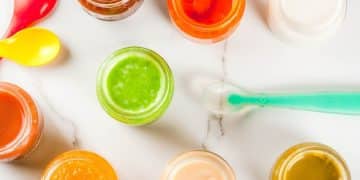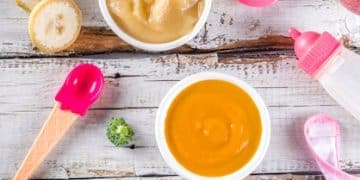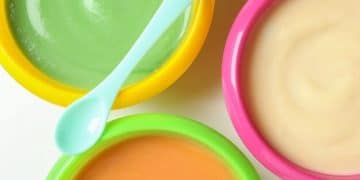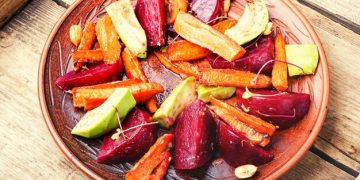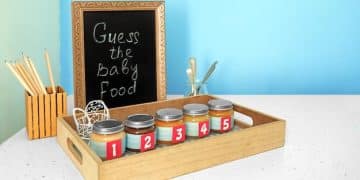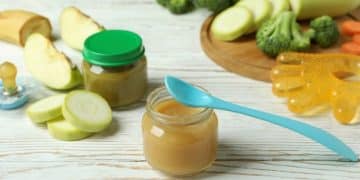Homemade Baby Food: Save 20% with These 3 Easy Recipes

Homemade baby food offers a cost-effective and nutritious alternative to store-bought options, allowing parents to control ingredients and save approximately 20% on feeding expenses. This article provides three simple, delicious recipes to get you started.
Starting your baby on solids is an exciting milestone, but it can also be an expensive one. Store-bought baby food can quickly add up, which is why making your own homemade baby food: 3 recipes that save you 20% compared to store-bought is a fantastic option for budget-conscious parents who want the best for their little ones.
Why Make Your Own Homemade Baby Food?
Making your own baby food might seem daunting at first, but it’s surprisingly simple and offers several benefits. Not only can you save money, but you also have complete control over what your baby eats. Let’s explore the advantages:
Cost Savings
One of the most significant advantages of making homemade baby food: 3 recipes that save you 20% compared to store-bought is the cost savings. Store-bought baby food can be expensive, especially if you opt for organic varieties. By making your own, you can significantly reduce your grocery bill.
Nutritional Control
Making your own baby food allows you to ensure that your baby is getting the freshest, most nutritious ingredients. You can choose organic fruits and vegetables and avoid added sugars, salt, and preservatives that are often found in store-bought options.
- Fresh Ingredients: Using fresh, whole foods ensures your baby gets a variety of essential vitamins and minerals.
- No Additives: You can be confident that your homemade baby food is free from artificial colors, flavors, and preservatives.
- Customization: Homemade baby food allows you to adjust recipes to suit your baby’s preferences and dietary needs.

In conclusion, making your own baby food provides a cost-effective and nutritious alternative to store-bought options. It allows you to control the ingredients and provide your baby with the freshest, most wholesome meals possible.
Essential Equipment for Homemade Baby Food
Before you start whipping up delicious purees, it’s helpful to have a few key pieces of equipment on hand. While you don’t need fancy gadgets, these items will make the process smoother and more efficient.
Steamer Basket
A steamer basket is essential for cooking fruits and vegetables to the perfect consistency for pureeing. Steaming helps retain nutrients better than boiling.
Food Processor or Blender
A food processor or blender is necessary for achieving a smooth, consistent puree. A high-speed blender works best, but a standard food processor will also do the trick.
- Immersion Blender: An immersion blender is a convenient option for blending directly in the pot, reducing cleanup.
- Baby Food Maker: All-in-one baby food makers steam and blend, further simplifying the process.
- Storage Containers: Invest in small, freezer-safe containers or ice cube trays for portioning and storing your homemade baby food.
Having the right equipment can make all the difference in preparing homemade baby food. Investing in a few essential tools will streamline the process and help you create nutritious meals for your little one with ease.
Recipe 1: Sweet Potato Puree
Sweet potato puree is a fantastic first food for babies. It’s naturally sweet, packed with nutrients, and easy to digest. Plus, sweet potatoes are readily available and relatively inexpensive!
Ingredients and Instructions
For this recipe, you’ll need one medium sweet potato. Start by washing, peeling, and chopping the sweet potato into small cubes. Steam the cubes until they are fork-tender, about 10-15 minutes.
Blending and Storage
Once the sweet potato is cooked, transfer it to a food processor or blender. Add a little water, breast milk, or formula to achieve a smooth consistency. Blend until smooth. Let the puree cool completely before transferring it to freezer-safe containers or ice cube trays.
- Freezing: Freeze in small portions for easy thawing.
- Thawing: Thaw in the refrigerator overnight or microwave for a quick meal.
- Serving: Serve at room temperature or slightly warmed.
Sweet potato puree is a simple, nutritious, and delicious first food for your baby. It’s easy to make in large batches and store for future meals, making it a convenient option for busy parents.
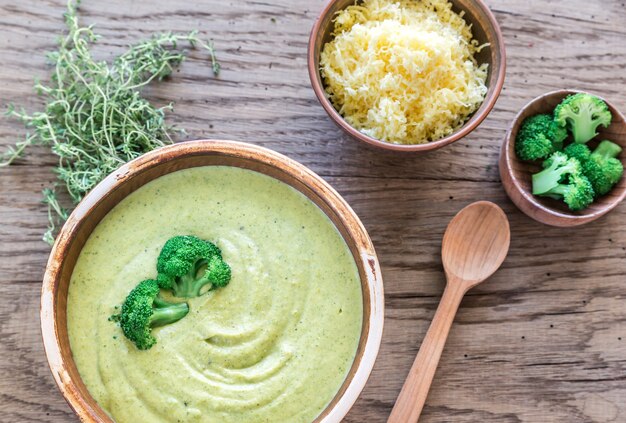
Recipe 2: Pea Puree
Pea puree is another excellent option for introducing your baby to new flavors and textures. Peas are a good source of vitamins, minerals, and fiber, which are essential for healthy growth and development.
Ingredients and Instructions
For pea puree, you can use fresh or frozen peas. If using fresh peas, shell them first. Steam the peas until they are tender, about 5-7 minutes. Frozen peas usually require less cooking time.
Blending and Serving
Transfer the cooked peas to a food processor or blender. Add a little water, breast milk, or formula to help achieve a smooth puree. Blend until smooth. Serve immediately or store in the refrigerator for up to 3 days.
Pea puree is a versatile and nutritious food that your baby is sure to enjoy. Its mild flavor and smooth texture make it an ideal choice for introducing solid foods.
Recipe 3: Apple Puree
Apple puree is a classic baby food that’s naturally sweet and easy to digest. Apples are a good source of fiber and vitamin C, making them a healthy choice for your little one.
Ingredients and Instructions
For apple puree, you’ll need one or two apples, depending on how much puree you want to make. Wash, peel, and core the apples. Chop them into small pieces.
Cooking and Blending
Steam the apple pieces until they are soft, about 8-10 minutes. Transfer the cooked apples to a food processor or blender. Add a little water if needed, and blend until smooth. Let it cool.
- Variations: Add a pinch of cinnamon for extra flavor.
- Texture: Adjust the amount of water for desired consistency.
- Storage: Store in the refrigerator for up to 3 days or freeze for longer storage.
Apple puree is a simple and delicious baby food that’s perfect for introducing your baby to fruits. Its naturally sweet flavor and smooth texture make it an appealing choice for even the pickiest eaters.
Tips for Saving Money on Baby Food
Making your own baby food is a great way to save money, but there are a few additional tips that can help you stretch your budget even further. Strategic planning and shopping habits can significantly reduce your expenses.
Buy in Bulk
Purchasing fruits and vegetables in bulk when they are in season can save you a considerable amount of money. Many fruits and vegetables can be frozen for later use, ensuring you always have a supply on hand.
Plan Your Meals
Planning your baby’s meals in advance can help you avoid impulse purchases and reduce food waste. Create a weekly meal plan and stick to your grocery list to stay on budget.
- Utilize Leftovers: Incorporate leftover fruits and vegetables from your own meals into your baby’s food.
- Grow Your Own: Consider growing your own fruits and vegetables in a garden or containers.
- Shop at Farmers Markets: Farmers markets often offer fresh, locally grown produce at lower prices.
By following these tips, you can maximize your savings and provide your baby with nutritious, homemade food without breaking the bank. Strategic planning and smart shopping habits are key to making the most of your budget.
| Key Point | Brief Description |
|---|---|
| 💰 Cost Savings | Homemade baby food can save you approximately 20% compared to store-bought options. |
| 🍎 Nutritional Control | You control the ingredients, ensuring fresh, additive-free meals. |
| 🥦 Easy Recipes | Simple purees like sweet potato, pea, and apple are great starting points. |
| 🛒 Smart Shopping | Buy in bulk, plan meals, and utilize leftovers to save even more. |
Frequently Asked Questions
▼
Homemade baby food can be healthier because you control the ingredients, avoiding additives and preservatives often found in commercial options. You can ensure fresh, organic produce is used.
▼
Homemade baby food can be stored in the refrigerator for up to three days. For longer storage, freeze it in small, airtight containers or ice cube trays for up to three months.
▼
Yes, frozen fruits and vegetables are an excellent option for making homemade baby food. They are often just as nutritious as fresh produce and can be more convenient and cost-effective.
▼
Introduce new foods one at a time, waiting a few days before introducing another. This helps you identify any potential allergies or sensitivities your baby may have to a specific food.
▼
Don’t give up! It may take several tries for your baby to accept a new food. Try mixing it with a food your baby already enjoys or introducing it again later.
Conclusion
Making homemade baby food: 3 recipes that save you 20% compared to store-bought is a rewarding way to ensure your baby gets the best nutrition while saving money. With simple recipes and strategic planning, you can provide delicious, wholesome meals for your little one without breaking the bank.
